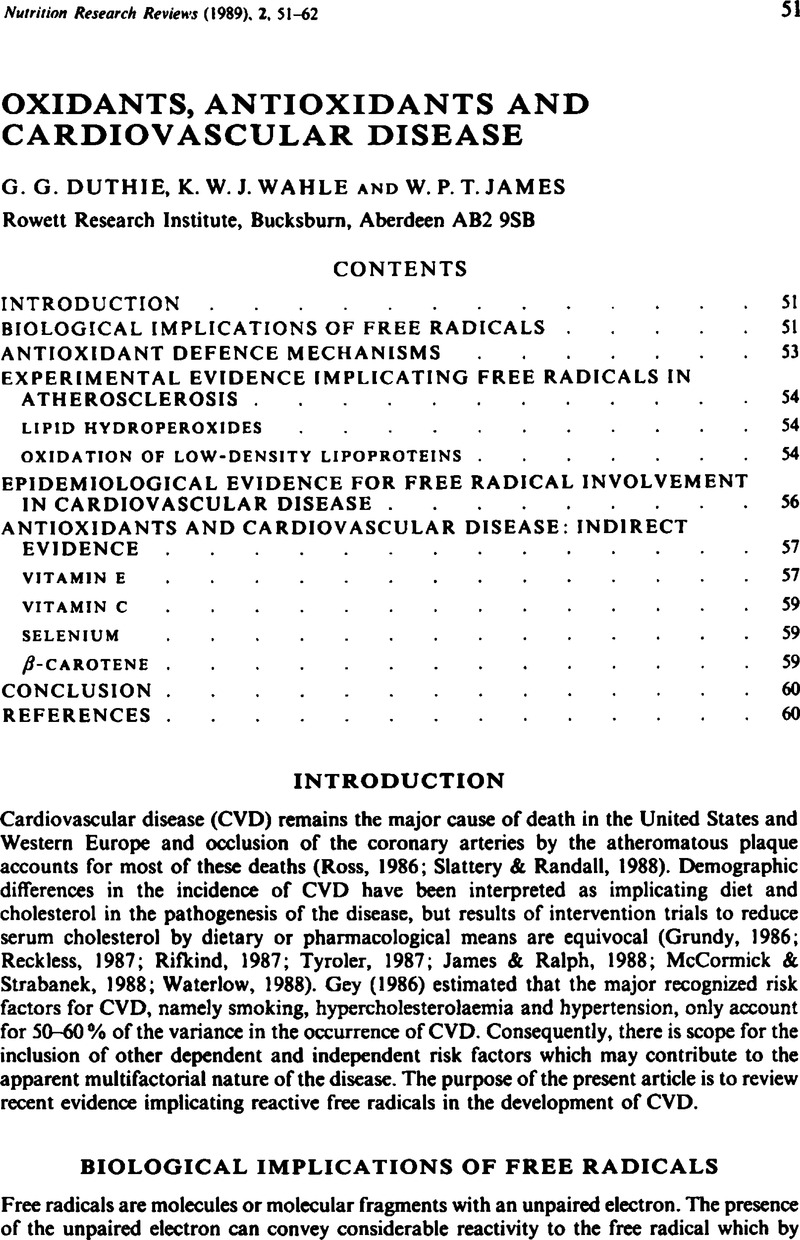Crossref Citations
This article has been cited by the following publications. This list is generated based on data provided by Crossref.
Duthie, Garry G.
1990.
Antioxidant Vitamins, Free Radicals and Coronary Heart Disease.
British Food Journal,
Vol. 92,
Issue. 8,
p.
32.
O'Brien, John
1991.
Dietary fish oil claims.
Trends in Food Science & Technology,
Vol. 2,
Issue. ,
p.
1.
Ulbricht, T.L.V.
and
Southgate, D.A.T.
1991.
Coronary heart disease: seven dietary factors.
The Lancet,
Vol. 338,
Issue. 8773,
p.
985.
Duthie, GG
Arthur, JR
and
James, W P T
1991.
Effects of smoking and vitamin E on blood antioxidant status.
The American Journal of Clinical Nutrition,
Vol. 53,
Issue. 4,
p.
1061S.
Ciavatti, Maryvonne
and
Renaud, Serge
1991.
Oxidative status and oral contraceptive. Its relevance to platelet abnormalities and cardiovascular risk.
Free Radical Biology and Medicine,
Vol. 10,
Issue. 5,
p.
325.
1991.
Diet and heart disease — Is there another factor?.
Nutrition Research,
Vol. 11,
Issue. 4,
p.
391.
Bolton-Smith, C.
Casey, C. E.
Gey, K. F.
Smith, W. C. S.
and
Tunstall-Pedoe, H.
1991.
Antioxidant vitamin intakes assessed using a food-frequency questionnaire: correlation with biochemical status in smokers and non-smokers.
British Journal of Nutrition,
Vol. 65,
Issue. 3,
p.
337.
Patriarca, Marina
Menditto, Antonio
and
Morisi, Gino
1991.
Determination of Ascorbic Acid in Blood Plasma or Serum and in Seminal Plasma Using a Simplified Sample Preparation and High-Performance Liquid Chromatography Coupled with Uv Detection.
Journal of Liquid Chromatography,
Vol. 14,
Issue. 2,
p.
297.
Ursell, Amanda
1991.
ANTIOXIDANT VITAMINS E AND C.
Nutrition & Food Science,
Vol. 91,
Issue. 6,
p.
8.
James, W. P. T.
and
Ralph, A.
1992.
Human Nutrition.
p.
1.
Menditto, A.
Menotti, A.
Morisi, G.
Patriarca, M.
and
Spagnolo, A.
1992.
Serum ascrobic acid levels in men aged 55–75 years: Association to selected social factors and biochemical parameters.
Archives of Gerontology and Geriatrics,
Vol. 15,
Issue. ,
p.
257.
Duthie, Garry G.
Shortt, Colette T.
Robertson, John D.
Walker, Kim A.
and
Arthur, John R.
1992.
Plasma antioxidants, indices of lipid peroxidation and coronary heart disease risk factors in a Scottish population.
Nutrition Research,
Vol. 12,
Issue. ,
p.
S61.
Croft, Kevin D.
Dimmitt, Simon B.
Moulton, Claire
and
Beilin, Lawrence J.
1992.
Low density lipoprotein composition and oxidizability in coronary disease — apparent favourable effect of beta blockers.
Atherosclerosis,
Vol. 97,
Issue. 2-3,
p.
123.
Bolton‐Smith, C.
Brown, C. A.
Woodward, M.
and
Tunstall‐Pedoe, H.
1992.
Milk consumption and prevalence of coronary heart disease in men and women from the Scottish Heart Health Study.
Journal of Human Nutrition and Dietetics,
Vol. 5,
Issue. 5,
p.
305.
Thompson, R. L.
Margetts, B. M.
Wood, D. A.
and
Jackson, A. A.
1992.
Cigarette Smoking and Food and Nutrient Intakes in Relation to Coronary Heart Disease.
Nutrition Research Reviews,
Vol. 5,
Issue. 1,
p.
131.
Diehl, J. F.
1992.
Die toxische Gesamtsituation heute. Gedanken zum WHO-Bericht “Diet, nutrition and the prevention of chronic diseases”.
Zeitschrift für Ernährungswissenschaft,
Vol. 31,
Issue. 4,
p.
225.
Kubow, Stan
1992.
Routes of formation and toxic consequences of lipid oxidation products in foods.
Free Radical Biology and Medicine,
Vol. 12,
Issue. 1,
p.
63.
Stockdale, Thomas
1993.
Cardiovascular Disease.
Nutrition and Health,
Vol. 9,
Issue. 2,
p.
151.
Fairweather‐Tait, Susan J.
1993.
Optimal nutrient requirements: important concepts.
Journal of Human Nutrition and Dietetics,
Vol. 6,
Issue. 5,
p.
411.
Bolton Smith, Caroline
Woodward, Mark
Brown, Colin A.
and
Tunstall Pedoe, Hugh
1993.
Nutrient intake by duration of ex-smoking in the Scottish Heart Health Study.
British Journal of Nutrition,
Vol. 69,
Issue. 2,
p.
315.





